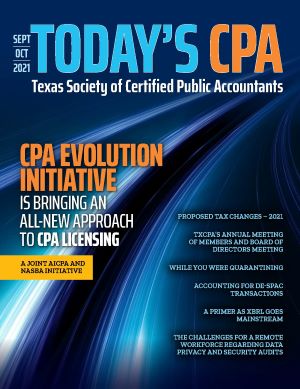A Primer as XBRL Goes Mainstream
By Don Carpenter, MSAcc/CPA
The Securities and Exchange Commission (SEC) in 2008 adopted a requirement for registrants, mutual funds and credit rating agencies to report key financial data and disclosure information in a machine-readable format known as eXtensible Business Reporting Language (XBRL). To date, the data has been filed as exhibits to required reports and posted on the reporting company’s website.
The file is also available on the SEC’s EDGAR reporting site. With the appropriate software (available through EDGAR), investors, financial advisors and analysts, as well as the SEC staff, have used the information to more efficiently access key financial data and assess performance across periods and against others within the database.
XBRL employs unique terminology. Understanding the vocabulary is key to understanding how XBRL works with the financial reporting framework. AICPA has identified several key terms with specific meaning in the context of XBRL.
Taxonomy: The dictionary or glossary for items required to be identified in reports. This could include financial data as simple as revenue on the income statement or a less prominent item such as the effective tax rate embedded within the tax footnote. There are over 15,000 possible items to be identified in the standard taxonomy. In addition, the taxonomy defines relationships between items. For example, Accounts Receivable links to Current Assets, which in turn links to Total Assets.
Tagging: The process of linking or identifying specific items (such as revenue) within a financial report to the taxonomy as defined by the SEC. The thoroughness and accuracy of this step is key to establishing reliable files that are consistent across multiple filers and time periods.
Instance Document: The file that accompanies a registrant’s financial report and includes the company’s specific information that has been tagged to the SEC taxonomy. An instance document should accompany each report (10-Q, 10-K, earnings release, etc.) and can be accessed and analyzed with the appropriate software.
Rendering: The process by which the machine readable XBRL data is translated to a human readable format.
Typically, the reporting entity will prepare its report (let’s assume it is the 10-K). The report will then be tagged with all required information being linked to the SEC taxonomy. Companies can also expand or adjust the pre-set taxonomy to fit their specific data, which is called “taxonomy extension.” The instance document is then prepared and is filed along with the 10-K.
More than half of registrants rely on a third party for the tagging and instance document preparation. The SEC will review the instance document for completeness and any obvious errors. Once filed, interested parties can access the instance document to perform data analysis and generate or “render” a report.
SEC staff members have noted several errors that commonly occur in instance documents that make comparative analysis difficult:
- Characterization of a number as negative when it is positive and vice versa;
- Incorrect scaling of a number (tagging as billion rather than millions, for example);
- Missing calculations that demonstrate relationships between data (subtracting cost of goods sold from revenue to get gross profit);
- Incomplete tagging (failure to tag numbers in parentheses);
- Inappropriate customized tagging.
These errors highlight the need for companies to include controls and procedures within their financial reporting process to address the accuracy of XBRL reporting. It is the reporting entities’ responsibility to ensure financial reporting accuracy even if XBRL tagging is performed by a third party. The SEC has attributed the high occurrence of these errors in part to the two-step procedure of preparing reports and then preparing XBRL data in a separate data file.
With technological improvements, XBRL reporting can be imbedded in an HTML document known as Inline XBRL. This eliminates the need to copy and tag the required information in a separate file. Inline XBRL results in a single document that is both human readable and accessible for data extraction and analysis by appropriate software. Viewing Inline XBRL data does not require specialized software, as the SEC has incorporated an Inline XBRL Viewer within the EDGAR system.
With the increasing reliance on technology and the availability of large amounts of data, accounting professionals are well advised to stay abreast of these trends.
About the Author: Don Carpenter is clinical professor of accounting at Baylor University. Contact him at Don_Carpenter@baylor.edu.

















